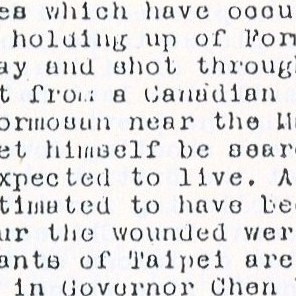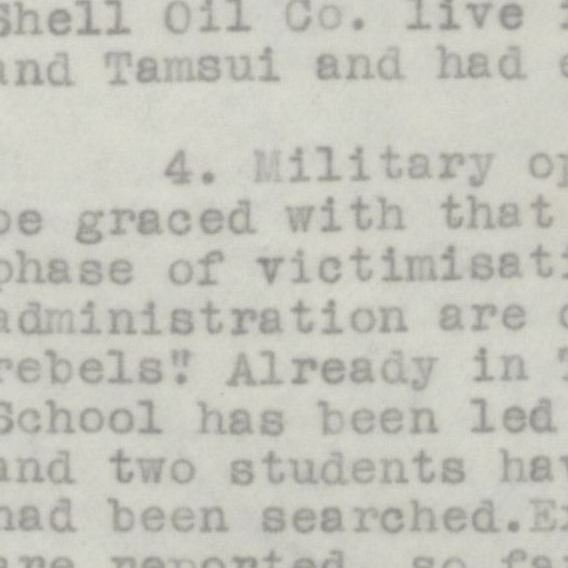Kè-sio̍k chē kang í-lâi ê thong-pò (khòaⁿ 19-hō, 20-hō), lâng tī Tâi-oân ê Eng-kok léng-sū G.M. Tingle, tī 1947 nî 3 goe̍h 15 koh chi̍t kái hiòng Lâm-kiaⁿ ê Eng-kok tāi-sài-koán hoat sìn-sek. Ē-kha sī Tâi-gí hoan-e̍k, Eng-gí goân-bûn, kiam Eng-kok Kok-li̍p Tóng-àn-koán (The National Archives) ê scan iáⁿ-siōng:
Eng-kok Léng-sū-koán,
Tām-chúi, Formosa,
1947 nî 3 goe̍h 15 ji̍t.
21-hō
(an-choân kòe-chhiú)
Thâu-ke,
Chham-chiàu góa chìn-chêng koan-hē pún khu-he̍k ê thong-pò, gún kong-êng
thong-ti tāi-jîn, Tâi-pak-siâⁿ kap Tām-chúi chit-má chiū gōa-khoán lâi khòaⁿ í-keng sī khoe-ho̍k
chèng-siông, tú-liâu tī kē-á-lō͘ koh ū sò͘-liōng bô chèng-siông ê tōa tīn peng-á. Siong-gia̍p
chóng-sī mā bē-tàng kóng í-keng khoe-ho̍k, chia̍h-mi̍h ia̍h tng khiàm-khoat.
2. Tōa tīn ê oân-peng, hông jīn-ûi í-keng hiòng lâm-pêng sóa-tāng, kun-kù pò-chai chit-má í-keng siū tio̍h pau-ûi ê Tâi-tiong, bī-lâi sī chhi-chhám--ê. M̄-koh chit tiám tī hia sī bô-kâng, Tâi-pak ê Formosa-lâng tiâu tī tùi 3 goe̍h 8 ji̍t àm-sî hia̍p-gī ê lo̍k-koan kám-kak, sīm-chì liân chhî-iú ê bú-chong lóng soah khiàm chún-pī; tī Tâi-tiong ê lâng, sī ū it-tēng thêng-tō͘ ê bú-chong jî-chhiá chiâⁿ pháiⁿ kóng sī bô chún-pī--ê. Chiàu pò-kò siū-siong ê peng-á í-keng tī cha-àm tùi lâm-pêng hông sàng ji̍p Tâi-pak. Kóng chit tiám sī beh kóng-kioh kap Tâi-pak ê tùi-pí, pí-kàu góa sī bô thiaⁿ kóng Tâi-pak ū peng-á tī téng lé-pài-bóe ê siā-kek tang-tiong hō͘ Formosa-lâng thâi-sí ia̍h siū-siōng.
3. Koan-hē tī Tâi-pak ê Formosa lâng tī hit-ê sî-chūn tang-tiong hông thâi-sí ê chêng-hêng, góa chīn-le̍k thang thê-kiong ê ko͘-sǹg, sī bô khah-chió 800 lâng, jî-chhiá khó-lâng ū 1,000 lâng ê chē. Chia chit-má iáu koh ài ka-chiūⁿ siū tio̍gh chhèng-sat, kiam tī kē-lō͘ hông ēng Ji̍t-pún-sek kun-to chàm-thâu (siong-tùi khah chió) chhú-hêng ê siū-lān-chiá. Ū pò-kò kóng 200 miâ ê ha̍k-seng tī Ke-lâng hông chhèng-sat, in ê sí-thé koh hông tàn ji̍p khì hái. Che kong-kéng ē-tàng kóng sī chin pháiⁿ lâi siong-sìn, m̄-koh hái-éng tng kā chi̍t kóa sí-thé chhiong chiūⁿ hōaⁿ. Tong-khoân tng leh lia̍h "phòaⁿ-loān-chiá", peng-á sī tng leh chhiúⁿ-kiap. Sui-bóng m̄-sī só͘-ū chhēng chè-ho̍k--ê tan-ūi ló͘ng sī án-ne; Formosa-lâng ê tîn-su̍t mā o-ló chi̍t kóa hiàn-peng, in tī chió-sò͘ ê àn-lē lāi-té, tī siú-hú siāng chhám ê kúi-kang-á ū hiòng chhiúⁿ-kiap--ê khui-chhèng. Hiah khan-liân tio̍h "phòaⁿ-loān" soah hông lia̍h--khì ê âlng ū Ông Thiam-teng, i sī Séng Chham-gī-hōe gī-oân, mā sī Chhù-lí Úi-oân-hōe ê úi-oân; koh ū Lîm Bō͘-seng, Bîn-pò ê siā-tiúⁿ; kiam Sòng Hui-jû, Jîn-bîn Tó-pò siā-tiúⁿ. Nā Lí Bān-ki, Sin-seng-pò ê siā-tiúⁿ, sī pat hō͘ peng-á lia̍h-tiâu-leh, m̄-koh chi̍t-ê hiàn-peng kan-sia̍p tiau-chhú--ah. Chiúⁿ Ūi-chhoan sêng-kong tùi in tau cháu-siám, m̄-koh in cha-bó͘-kiáⁿ soah hō͘ khì lia̍h i ê kéng-chhat-koaⁿ khui-chhèng siā tio̍h-siong. Jī-jī-pat Sū-kiāⁿ Chhù-lí Úi-oân-hōe tī 3 goe̍h 10 ji̍t hông hā-lēng kái-sàn, lí-iû sī in chhiau-kòe chè-hān ê chèng-tī iau-kiû, kiam óa beh tùi chó͘-kok ê phòaⁿ-loān.
4. Chhù-lí Úi-oân-hōe thê-chhut ê 32 hāng iau-kiû (chhiáⁿ khòaⁿ góa 17-hō thong-pò) hō͘ pún-tē chèng-hú sái-lāng tī chhiú tiong. Chiang jīn-ûi Tân Gî tī sū-chêng í-keng tit tio̍h koan-hē chi̍t kóa iau-kiû ê siau-sit, i m̄-chiah thang tī iau-kiû hoêng si̍t-chè thê-chhut chìn-chêng, sìn-sok tit tio̍h tiong-iong chèng-hú ún-tùn oān-chō͘. N á Chiúⁿ Kài-se̍k tī 3 goe̍h 10 ji̍t ê Kì-liām-chiu ián-káng tang-tiong kóng--ê: "só͘-ūi Jī-jī-pat Sū-kiāⁿ Chhù-lí Úi-oân-hōe hut-jiân-kan tī 3 goe̍h 7 ji̍t thê-chhut bû-lí iau-kiû, pí-lūn hòe-tû Kéng-pī Chóng-piū, kok-ka pō͘-tūi kái-tû bú-chong, kiam Tâi-oân lio̍k-siōng, hái-siōng, khong-tiong bú-le̍k hō͘ Tâi-oân-lâng cho͘-chit. Chia iau-kiû chhiau-kòe tē-hng hêng-chèng ê kài-hān, só͘-í Tiong-íong bē tit chiap-siū." Tân-gí toàn-jiân kī-choat ê nn̄g tiám sī Kéng-pī Chóng-pō͘ ê hòe-tû kap Choan-bē-kio̍k ê hòe-tû. Tong tiong-iong chèng-hú tùi bó͘ chi̍t kóa iau-kiû put-ho̍k ê sî, i to̍h bô su-iàu kè-sio̍k hoan-ló ê lí-iû. Tng chiân-óng Ji̍t-pún lō͘--lin ê pō͘-tūi choán hiòng pún só͘-chāi, toh ē-tàng pí jīn-hô lâng àn-sǹg ê khó-lêng oân-peng koh khah kín kàu-ūi, siâng-sî Kàm-chhat-īⁿ 監察院 閩臺區 監察使 楊亮功 mā lâi kàu. Tùi Tâi-pak ê khióng-hat chū i kàu ūi liáu-āu kúi tiám-cheng lāi tiō khai-sí ah. Chhiú-lō͘ sī cheng-kong sūn-lī. Formosa-lâng sī gông-ngia̍h--khì. Tû-liáu chin lāu-pòe--ê, bô lâng ē-tàng siūⁿ khí Ji̍t-pún thóng-tī ē-té ū siáⁿ thang pí-phēng.
5. Tī Kì-liām-chiu ián-káng lāi Tāi-goân-sè kóng tio̍h tiong-iong chèng-hú beh phài chi̍t ūi ū tōa chhiú-oán ê koaⁿ-oân kòe khì pang-chō͘ tiúⁿ-koaⁿ Tân Gî kái-koat chòe-kīn ê chit hāng tāi-chì. Hit-ê lâng khó-lêng sī 白崇禧, i tī 3 goe̍h 13 ji̍t kàu chia白崇禧 sī 3 goe̍h 17 chiah kàu Tâi-oân, Tingle āu--lâi tī lēng-gōa ê thong-pò ū siu-chèng chit tiám.
6. Formosa-lâng bī-lâi ê kong-kéng sī chhi-chhám--ê. In kap Tāi-lio̍k-lâng bī soan-kò chiàn-cheng chit-má í-keng chiâⁿ chò kòe soan-kò ê chiàn-cheng, put-koán sī toh chi̍t khoán hâng-gia̍p lóng khó-lêng soe-thè. Au-pái chit-ê kok-tō͘ to̍h éng-oán m̄-sī koh hiah-nī-a bô lâng hông-pī. Formosa-lâng soah--lo̍h-lâi koh ē-sài--ê, sī ùi chi̍t-ê siū chiàm-niáu ê kok-tō͘ ê jîn-bîn ê tē-hā hoán-khòng. Tó-sū téng-bīn ê keng-chè ho̍k-goân khòaⁿ--khí-lâi sī bû-hān iân-kî loh.
Sir Ralph S. Stevenson C.M.G.,
Pē-hā ê Tāi-sài,
Eng-kok Tāi-sài-koán,
Lâm-kiaⁿ.
Gún ū êng-hēng chò,
Thâu-ke,
Kok-hā siāng sūn-ho̍k,
khiam-pi ê Chhe-ia̍h
G.M.Tingle
Tāi-lí Léng-sū.
British Consulate,
Tamsui, Formosa,
15th March 1947.
No.21.
(By safe hand)
Sir,
With reference to my previous despatches on the situation in this
district I have the honour to inform Your Excellency that Taipei city and Tamsui are now back to
normal as regards appearances, except for the abnormally large number of soldiers on the streets.
Business cannot be said to have resumed however, and food is scarce.
2. The bulk of the reinforcements are believed to have moved south, and the prospect for Taichu, now reported encircled, is a dismal one. There will be this difference, however, that whereas the Formosans of Taipei were caught in an optimistic mood over the negotiations on the night of the 8th March, unprepared and so without even the arms which they had, those at Taichu are armed to some degree and can hardly have been unprepared. Wounded soldiers are reported to have been brought into Taipei from the south last night. This only serves to heighten the contrast with Taipei, where I have heard no reports of soldiers being killed or wounded by Formosans during the shooting last week—end.
3. The most likely estimate that I can give of Formosans killed in Taipei during that period is not less than 800, and perhaps as many as 1,000. To these must now be added the victims of executions by shooting, and by beheadings in the streets with Japanese officers' swords (comparatively rare). There is a report that 200 students were shot in Keelung and their bodies thrown into the sea. This figure can hardly be believed, but some bodies are being washed up by the tide. The administration are hunting out "rebels" and the soldiers are doing some looting. Not all uniformed bodies though; Formosan reports give praise to the gendarmes who in a few cases shot looters during the worst days of the capital. Those arrested in connexion with the "revolt" include Wang Tien-ting, a member of the Provincial Political Council and also a member of the Disposal Committee, Lin Mou-sheng, president of the Min Pao, and Sung Fai-Ju, president of the Jen Min Tao Pao. Li Wan-chu, president of the Hsin Sheng Pao was manhandled by a soldier, but a gendarme intervened. Chiang Wei-chuan made good his escape from his home, but his daughter was injured when the police officials who called to arrest him opened fire. The February 28th Affair Disposal Committee was ordered on March 10th to be dissolved, on the grounds that its action had overstepped the limits of political demands and neared a revolt against the fatherland.
4. The 32-point demand presented by the Disposal Committee (please see my despatch no.17) played into the hands of the local government. It is believed that having had prior word of some of the points Chen Yi was able to get a quick promise of aid from the Central Government before the demand was actually presented. As Chiang Kai-shek said in his Memorial Week speech of the 10th March: "the so—called February 28th Affair Disposal Committee suddenly on March 7th presented unreasonable demand such as the abolition of the Garrison Headquarters, the laying down of arms by the national forces, and the organisation of the land, sea, and air forces in Taiwan by Taiwanese. These demands overstep the limits of local administration and therefore cannot be accepted by the Central Government." The two points on which Chen Yi was adamant were the abolition of the Garrison Headquarters and the abolition of the Monopoly Bureau. When the Central Government took exception to some of the demands he had no further cause for worry. Troops that were on the way to Japan were diverted here, thus arriving faster than anyone expected reinforcements to be possible, and Yang Liang-kung, District Supervisor of the Supervisory Yuan for Fukien and Taiwan Districts arrived simultaneously. Within a few hours of his coming the intimidation of Taipei had begun. The policy has succeeded handsomely.The Formosans are dumbfounded. None but the very senior ones can remember anything comparable under Japanese rule.
5. In the Memorial Week speech referred to the Generalissimo stated that the Central Government would send an official of great calibre to assist Governor Chen in the solution of the present affair. This may be Pai Chung-hsi, who arrived here on March 13th.
6. The future outlook for the Formosans is bad. The undeclared war between them and the mainlanders is now a declared war, whatever professions may be made to the contrary. Hence the country will never again be left so unguarded. It follows that all that remains to the Formosans will be the underground resistance of the people of an occupied country. The economic recovery of the island seems indefinitely postponed.
Sir Ralph S. Stevenson C.M.G.,
His Majesty's Ambassador,
British Embassy,
Nanking.
I have the honour to be,
Sir,
Your Excellency's most obedient,
humble Servant.
G.M.Tingle
Acting Consul.


Goân-bûn chhut-chhù sī Eng-kok Kok-li̍p Tóng-àn-koán ê "FO 371/63425" tóng-àn.

